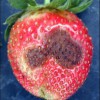 Florida’s producers use fungicides to manage anthracnose and botrytis fruit rot diseases, which find favorable growth conditions in Florida’s climate and can reduce strawberry yields and profits. The Strawberry Advisory System (SAS) uses information about weather conditions and user-entered information about past fungicide applications to evaluate the potential spread of these diseases in strawberry fields. If the risk of disease spread is low, no fungicide application is recommended, allowing producers to save on fungicide application costs. In this study, we summarize the results of a 2012/2013 survey of strawberry producers, and focus on the questions, How significant is the impact of anthracnose and botrytis on Florida strawberry producers’ yields? What are the typical fungicide application frequencies used by the producers? What percent of strawberry producers use SAS? and Are there any effects of SAS subscription on producers’ fungicide application? This 4-page fact sheet was written by Tatiana Borisova, Zhengfei Guan, Ekaterina Vorotnikova, Natalia Peres, and John VanSickle, and published by the UF Department of Food and Resource Economics, October 2014.
Florida’s producers use fungicides to manage anthracnose and botrytis fruit rot diseases, which find favorable growth conditions in Florida’s climate and can reduce strawberry yields and profits. The Strawberry Advisory System (SAS) uses information about weather conditions and user-entered information about past fungicide applications to evaluate the potential spread of these diseases in strawberry fields. If the risk of disease spread is low, no fungicide application is recommended, allowing producers to save on fungicide application costs. In this study, we summarize the results of a 2012/2013 survey of strawberry producers, and focus on the questions, How significant is the impact of anthracnose and botrytis on Florida strawberry producers’ yields? What are the typical fungicide application frequencies used by the producers? What percent of strawberry producers use SAS? and Are there any effects of SAS subscription on producers’ fungicide application? This 4-page fact sheet was written by Tatiana Borisova, Zhengfei Guan, Ekaterina Vorotnikova, Natalia Peres, and John VanSickle, and published by the UF Department of Food and Resource Economics, October 2014.
http://edis.ifas.ufl.edu/fe957